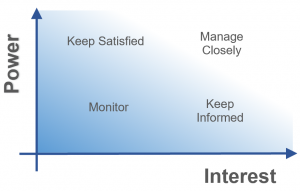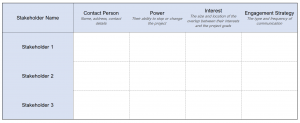
A stakeholder matrix is a project management tool used to analyze a project stakeholder to determine the actions which are necessary to align their goals with the project. There are several different types of stakeholder matrices:
- Power Interest matrix
- Stakeholder analysis matrix
- Stakeholder Engagement Assessment matrix
Power-Interest Matrix
In a stakeholder analysis, there are two variables which affect the project more than any other: Power and Interest.
- Power is the ability of the stakeholder to stop or change the project. For example, a government regulatory approval authority has a very high level of power.
- Interest is the size of the overlap between the stakeholder’s and the project’s goals. For example, a landowner who’s house has to be removed to make way for a project has a very high interest.
These two central variables are plotted on a chart with the x-axis being interest and the y-axis being power. The resulting chart might feel very simple but it is a solid analysis of the stakeholder’s interaction with the project.

- Stakeholders with high power and high interest are major stakeholders that are heavily invested in the project. They must be actively managed.
- Stakeholders with high power but low interest must be kept satisfied. They can derail the project over seemingly minor issues.
- Stakeholders with low power but high interest must be kept informed. They can create high influence (i.e. raise a stink) if they don’t get what they want.
- Stakeholders with low power and low interest must be monitored, in case they become more powerful and affect the project in the future.
Stakeholder Analysis Matrix
Since stakeholder analysis focuses on the two variables of Power and Interest, these variables are given plenty of attention. The stakeholder analysis matrix summarizes those two variables in a summary table, like this:
For larger projects a written stakeholder engagement plan is necessary to expand on these two variables further, but the table is a great summary reference regardless.
Stakeholders are analyzed based on many factors, which include:
- Financial interests, like profit and ability to earn money in the future.
- Moral and ethical values, which relate to societal norms for behavior.
- Religious beliefs that impact their worldview.
- Political opinions that govern how they respond to the project.
- Business interests, for example the increase of their present or future business.
- Demographics, as younger people and older people may have different preferences.
- Environmental stewardship, like protection of wildlife or vegetation.
- Value of ownership, for example a house, vehicle, or property.
- Communication preferences can play a large part when the wrong medium of communication is used.
The stakeholders are prioritized into power and interest levels based on these factors, and a stakeholder engagement strategy is developed from that.
Stakeholder Engagement Assessment Matrix
This matrix governs the project management team’s stakeholder management activities during project execution. It is developed during project planning and updated as new information about stakeholder buy-in is obtained.
Every stakeholder falls into one of the following five categories based on level of support for the project:
- Unaware
They are not aware of the project and its potential impacts on them. - Resistant
They are aware of the project but not in support of it. - Neutral
They are aware of the project but have no opinion regarding their support for it. - Supportive
They are supportive of the project and wish it to succeed. - Leading
They are actively engaged in project success and willing to lend assistance to help it succeed.
The stakeholder engagement assessment matrix, specified in the Project Management Body of Knowledge (PMBOK) within the Plan Stakeholder Management process, classifies each stakeholder into their current status (C), and their desired status (D).
This facilitates tracking of stakeholder buy-in activities. If a stakeholder, for example, is currently in the “unaware” category but needs to move into the “supportive” category, this process can be actively tracked until the “C” and the “D” are in the same column.
Often, stakeholders start out in the “unaware” or “resistant” categories but must be moved into the “neutral” or “supportive” categories. These are difficult situations that require active management to change a stakeholder’s mind.








